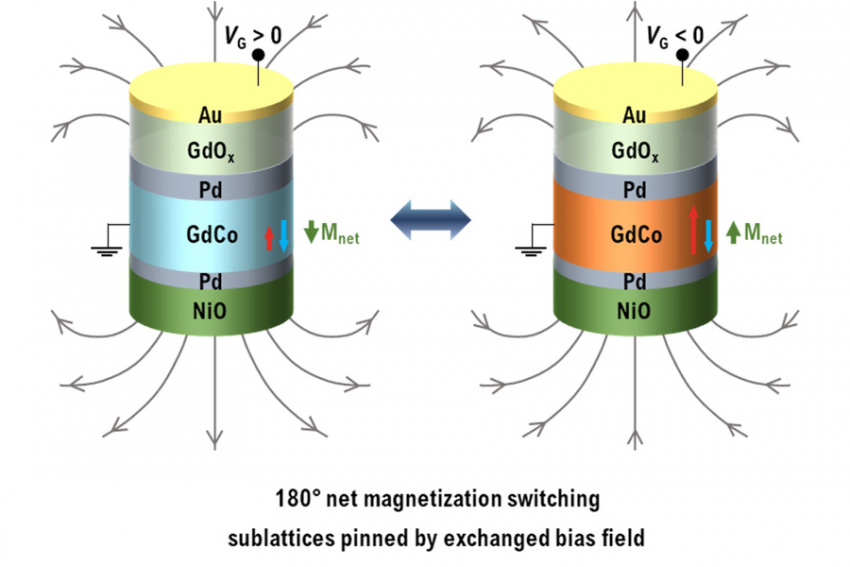Researchers at MIT have developed a way of quickly changing the magnetic polarity of a ferrimagnet 180 degrees, using just a small applied voltage. According to the researchers, the discovery could herald a new era of ferrimagnetic logic and data storage systems.
The findings were published in the journal Nature Nanotechnology in a paper co-authored by postdoctoral researcher Mantao Huang, MIT professor of materials science and technology Geoffrey Beach, and professor of nuclear science and technology Bilge Yildiz, as well as 15 other researchers from MIT and other institutions in Minnesota, Germany, Spain, and Korea.
The majority of magnets we come across are of “ferromagnetic” materials. The atoms in these materials are oriented in the same direction with their north-south magnet axes; thus, their combined strength is strong enough to create attraction. As a result, these materials are often used in the modern high-tech environment.

Magnets made of ferrimagnetic materials with an ‘i’ are less prevalent. Some of the atoms are aligned in one direction, while others are positioned the other way. As a result, if more atoms point in one direction than the other, the difference produces a net magnetic field in that direction.
The magnetizations of gadolinium (red) and cobalt (blue) atoms are shown through arrows. When the voltage is applied to electrodes (yellow patches), hydrogen is loaded in the magnetic material, which alters the relative magnetization magnitude thereof, reverse the direction of the total magnetic field.
Ferrimagnetic materials should construct data storage or logic circuits that are faster and pack more than today’s typical ferromagnets since external forces strongly impact their magnetic characteristics. However, the orientation of these magnets has not rapidly and reliably changed so that it flips from 0 to 1.
The MIT researchers employ the new method with a film of gadolinium cobalt, a rare earth transition metal ferrimagnet material. Both elements are made up of interconnected lattices of atoms, with the gadolinium atoms’ magnetic axes pointing in one direction and the cobalt atoms going in the other. The magnetization of the material is determined by the balance of the two in the alloy composition.

However, researchers found that oxygen can be released using a voltage to divide water molecules into oxygen and hydrogen along the film surface while the hydrogen atoms or nuclei penetrate the material thoroughly, and the magnetic orientation balance can be adjusted. The adjustment is enough to modify the magnetic field orientation to 180 degrees – just like the inversion required for devices like magnetic memory.
“We found that by loading hydrogen into this structure, we can reduce the gadolinium’s magnetic moment by a lot,” Huang explains. The magnetic moment measures the strength of the field produced by the atom’s spin axis alignment.
As the change is only made by a voltage adjustment, rather than an applied heat-causing electric current, it is an energy-efficient process, adds Beach, who co-directs the Materials Research Laboratory at MIT.
“You would think that if you take some material and pump some other atoms or ions into that material, you would expand it and crack it. But it turns out for these films, and by virtue of the fact that the proton is such a small entity, it can infiltrate the bulk of this material without causing the kind of structural fatigue that leads to failure.”
Extensive testing has proven the stability of the system. According to Huang, the material was put through 10,000 polarity reversals and showed no signs of wear.
Beach claims that the material has other qualities that could be beneficial in the future. According to him, the magnetic alignment between the individual atoms works like springs. This spring-like force pulls one atom back if it starts to shift out of alignment with the others. This way, waves are created that can pass through the material.

“For this magnetic material, these are called spin waves. You get oscillations of magnetization in the material, and they can have very high frequencies.”
“They can oscillate upward of the terahertz range”, he added, “which makes them uniquely capable of generating or sensing very high-frequency electromagnetic radiation. Not a lot of materials can do that.”
Simple uses of this phenomenon, such as sensors, could be developed in the future. However, applications such as data and logic circuits will take longer as the field of ferrimagnet-based technology is still in its infancy.
The basic methodology could have further applications as well, Beach says. “This is a way to control properties inside the bulk of the material by using an electric field,” he explains. “That by itself is quite remarkable. Other work has been done on controlling surface properties using applied voltages, but the fact that this hydrogen-pumping approach allows such deep alteration allows control of a broad range of properties,” he added.


